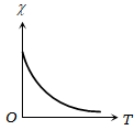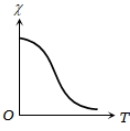Two magnets \(A\) and \(B\) are identical and these are arranged as shown in the figure. Their length is negligible in comparison to the separation between them. A magnetic needle is placed between the magnets at point \(P\) which gets deflected through an angle \(\theta\) under the influence of magnets. The ratio of distance \(d_1\) and \(d_2\) will be:

1. \((2\tan\theta)^{\frac{1}{3}}\)
2. \((2\tan\theta)^{\frac{-1}{3}}\)
3. \((2\cot\theta)^{\frac{1}{3}}\)
4. \((2\cot\theta)^{\frac{-1}{3}}\)

1. \((2\tan\theta)^{\frac{1}{3}}\)
2. \((2\tan\theta)^{\frac{-1}{3}}\)
3. \((2\cot\theta)^{\frac{1}{3}}\)
4. \((2\cot\theta)^{\frac{-1}{3}}\)
Two identical bar magnets with a length of 10 cm and weight 50 gm-weight are arranged
freely with their like poles facing in an inverted vertical glass tube. The upper magnet
hangs in the air above the lower one so that the distance between the nearest pole of the
magnet is 3mm. Pole strength of the poles of each magnet will be:
1. 6.64 ampm
2. 2 ampm
3. 10.25 ampm
4. None of these
Each atom of an iron bar (5 cm × 1 cm × 1 cm) has a magnetic moment . Knowing that the density of iron is atomic weight is 56 and Avogadro's number is the magnetic moment of the bar in the state of magnetic saturation will be:
1. 4.75 Am2
2. 5.74 Am2
3. 7.54 Am2
4. 75.4 Am2
A dip needle vibrates in the vertical plane perpendicular to the magnetic meridian. The time period of vibration is found to be 2 seconds. The same needle is then allowed to vibrate in the horizontal plane and the time period is again found to be 2 seconds. Then the angle of dip is
1. 0o 2. 30o
3. 45o 4. 90o
A dip needle lies initially in the magnetic meridian when it shows an angle of dip at a place. The dip circle is rotated through an angle x in the horizontal plane and then it shows an angle of dip . Then is
1. 1/cos x
2. 1/sin x
3. 1/tan x
4. cos x
A bar magnet has coercivity . It is desired to demagnetize it by inserting it inside a solenoid 12 cm long and having 60 turns. The current that should be sent through the solenoid is
1. 2 A 2. 4 A
3. 6 A 4. 8 A
For substances hysteresis (B - H) curves are given as shown in figure. For making temporary magnet which of the following is best?
| 1. |  |
2. |  |
| 3. |  |
4. |  |
The variation of magnetic susceptibility with temperature for a diamagnetic substance is best represented by
1. 
2. 
3. 
4. 
The variation of magnetic susceptibility with absolute temperature T for a ferromagnetic material is
1. 
3. 
The relative permeability of a ferromagnetic substance varies with temperature (T) according to the curve:
1. A
2. B
3. C
4. D










